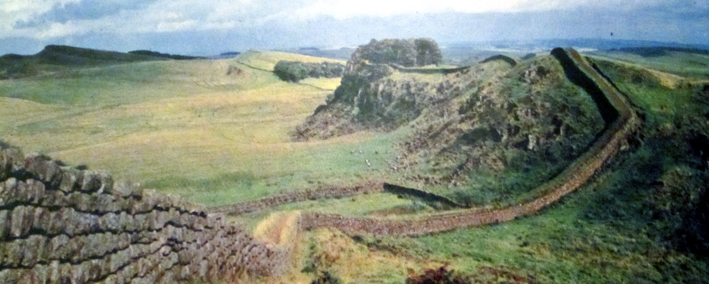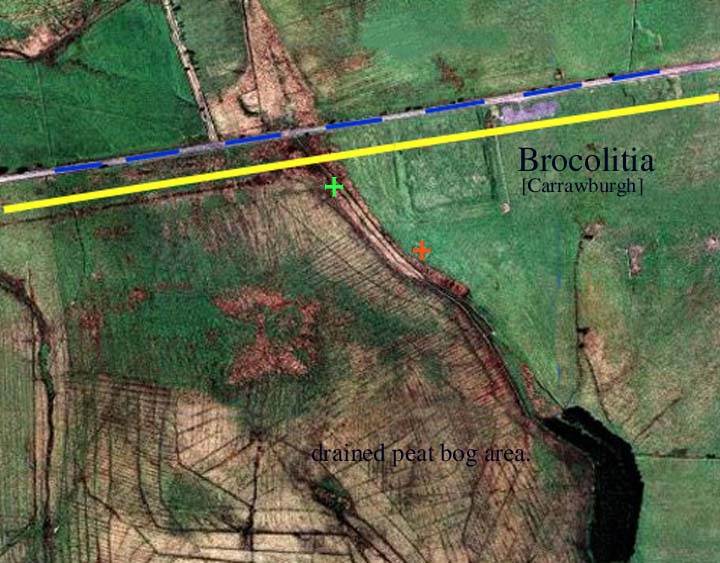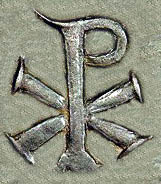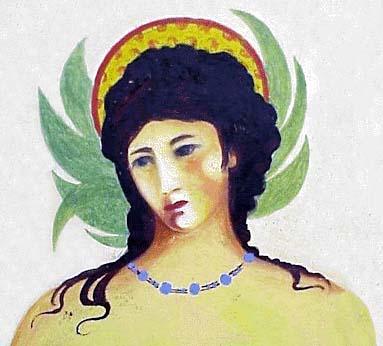

|
 |

Brocolitia = Carrawburgh Roman fort part of Hadrian's Wall.
The Wall and Vallum did not deviate from their line here, but passed through the upper part of the spring which is thrown out by the geology, a dolerite dyke in the carboniferous limestone. This is a wild part of the wall and countryside. J. Collingwood Bruce described it as 'all desolation'. Carrawburgh Roman fort lies about three and a half miles west from Chesters, measuring some 460 feet north to south and 360 east to west, an area of about 3.5 acres. It had gateways to the east south and west, its northern wall being the great wall of Hadrian itself. |
Following an excavation in 1876, it has been recognised that this well site was a sacred shrine to the goddess Coventina. Coventina's well-shrine lay close to a Mithraic temple, demonstrating the ability for two different, but now extinct religions, to exist coevally. The Romans were tolerant of most faiths, provided they did not threaten the political values of the Roman Empire. If the site can teach us anything, it is religious tolerance. We might think of the present inability of some of today's religions to tolerate one another and perhaps learn from this. Nature and history dictate that unless they evolve, they will not survive. . 
|
||
Although
this image is taken from the wall plaster of Lullingstone Roman
villa, it here represents Coventina, the Romano-British goddess. She was a goddess
of a pre-Christian era and as such represented part of the celebration
of nature. Late in the occupation of Britain, the old religions were
swept away under Emperor Constantine, the chi-rho and the swastika
became the symbols of the new religion.
the Romano-British goddess. She was a goddess
of a pre-Christian era and as such represented part of the celebration
of nature. Late in the occupation of Britain, the old religions were
swept away under Emperor Constantine, the chi-rho and the swastika
became the symbols of the new religion.After the fall of the Roman empire, troops were withdrawn from Albion or Britannia, this form of nature veneration then returned with the later arrival of the Angles, Saxons, Jutes and Danes to dominate the social landscape. From these groups developed the ideas of water-nymphs or fairies, a revival of the Coventinian religion. The Roman Fort of Brocolitia was garrisoned originally by the first cohort of Cugerninians and first cohort Aquitanians. Later, by the first cohort of Batavians in the 200-300's.
© Copyright Tim Midgley 2007, revised 9th November 2011. |
The
shrine dedicated to Coventina is similar to temple number three
at Springhead, near Dartford, Kent. The Springhead site tells us
that the visitors believed that the waters had healing properties,
small bronze models of a human arm, hand and thumb have been found
. Besides Coventina there were other Romano- British deities such as Sulis and Nodens, both Sulis and Coventina are represented at Bath in Somerset [Aquae Sulis]. Other Roman Gods were: 1.Venus - goddess of fertility 2. Minerva 3. Apollo 4. Jupiter 5. Diana 6. Vulcan 7. Hercules 8. Mars - god of war 9. Mercury - patron of travellers, merchants, traders and crafts. . 
A Roman mosaic swastika or fylfot, a type of Christian cross Sources: * J. Collingwood Bruce [ed. I.A Richmond. Handbook to the Roman Wall. Andrew Reid and Co. 1957. * Archaeology Aeliana series 2 viii 1, 20, 43. * Ibid. series 4 xxix 1. * Proceedings of the Society of Antiquaries of Newcastle upon Tyne. series 2 x 161. Further reading: * Allason-Jones L. & McKay B. Coventina's Well. Clayton Collection Chester Museum 1985. See : Birdoswald - King Arthur's last stand Chance favours the prepared mind - Louis Pasteur. Previous page . |